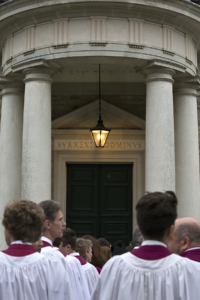
Dean Fr Martin Boland: Homily Vespers Dedication of Brentwood Cathedral.
An anniversary allows us to reflect on two movements: where we have come from and where we are going. In the case of Brentwood Cathedral, the mother church of the diocese, this silver jubilee of its Dedication provides us with an opportunity to consider these things with a spirit of thanksgiving.
Where, then, have we come from? It is good to remember collectively what inspired this building and what it means. The chief function of any church building is to speak about God – that is obvious. For most of its history, the Church has approached the mystery of God through its expressive art, because, by doing so, it affirms the essential unity of creation that echoes the eternal unity of God himself, Father, Son and Holy Spirit. Indifference to art and beauty is the most serious sign of decay in any institution – a sign that the dry rot of utilitarianism, iconoclasm or various strains of fundamentalism have taken hold.
But our buildings do not speak of God in some generalised, anaemic way. Every age and culture finds its own voice, its own dialect with which to speak of the mystery of the Triune God. Each church speaks in a different way of some aspect of this mystery and thus exercises a powerful influence on how we understand ourselves and our mission.
And here? With what kind of voice does Brentwood Cathedral speak? With, may I suggest, the voice of eloquent clarity that allows every dimension of the Christian life to find expression without the filigree of distorting accretions or the clutter of religious cliche. Baptismal font, ambo, altar, cathedra, Blessed Sacrament chapel and Reconciliation Rooms, each element, in proper relationship to the other, is given the space to articulate with a refreshing purity the fact of God’s living presence among us.
And what does this building say? It says one thing and it says it unashamedly, boldly: Surrexit Dominus, the crucified Lord is Risen. Surrexit Dominus is chiselled in gold above the main doors, but this message of good news is also to be found in the very form and shape of this interior, in the quality of light, the texture of the walls and floors, the craftsmanship and the beauty of the design and artefacts that we look at and handle. Every element here is dense with meaning quite beyond what we can immediately see. This is a building of light and hope, an eschatological hope in the future glory that awaits us, the life of the world to come, Surrexit Dominus.
No church building is ecclesiologically innocent: it expresses a sense of what it means to belong to the church, the respective roles of different ministries, the wealth or poverty of the Christian imagination, the sense of where Christ is to be found and so on. It is much more than a sermon in stone: it is a multimedia presentation of the Christian gospel, communicated in the shape of the building, its interior arrangements, its light and decoration, the kind of interaction it fosters or prohibits among the worshippers.
This is very clear here. Look around you. This is a building that finds a unique syntax to express the fact that we are beings in relationship, that our worship is corporate and collective. This is a building that calls us to participate, both internally and externally, in the sacred mysteries that we celebrate here, that we are not an impassive audience, watching some rarefied drama, but that, through our baptisms, we are participants in that drama we call the Paschal Mystery. Finally that we are a Eucharistic community, that we live by grace, that it is Jesus Christ, the Lamb of God who takes away the sins of the world, who is the centre and circumference, the height and depth of all we are as a community of faith.
And where are we going? The future? During this Year of Mercy, I have shown hundreds of primary and secondary school children around the Cathedral. My tour starts outside at the main doors and with a Latin lesson. What do you think the words Surrexit Dominus mean? Fire Exit? Some suggest. Way out? Welcome? No, I say, it means the Lord is Risen and then I ask them, what do you think that means? On one occasion, a little boy from a school in Walthamstow replied, “The Lord is Jesus…and…and Jesus is Risen and we need to rise with him.” It’s not a bad response to a difficult theological question…but it was the word “need” in the answer that struck me. We need to rise with him. Not we “must” or “try to” or are “obliged” or “ordered to” but we need to rise with him.
 Yes and we need this building to continue to speak with eloquent clarity of the Resurrection.
Yes and we need this building to continue to speak with eloquent clarity of the Resurrection.
We need it to be a canticle of praise, a composite language of faith and an expression of our hope in Jesus Christ, the Wounded Healer.
We need to rise above superficial readings of this building or views motivated by pathological anxieties about Catholic identity and understand that this building’s deepest and truest identity is the Risen Christ.
We, along with the men and women of our crooked age, need to hear the stones and beauty and light of this building proclaim, Surrexit Dominus.
This is where we have come from. This is the mystery that we are caught up in now and it is, indeed, the future glory that awaits us.
